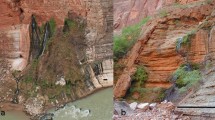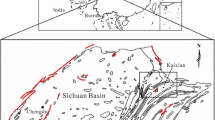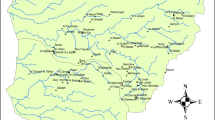Abstract
The regional carbonate aquifer in the carbonate-rock province of the Great Basin, USA, covers thousands of square kilometers. It is a significant potential source of water for growth in this arid area. Few wells penetrate the carbonate aquifer, so information on water quantity and quality is derived in large part from ‘regional springs’ that discharge from regional interbasin flow systems. For this study, springs in the carbonate-rock province were sampled; their physical, chemical, and isotopic characteristics were compared to those of known regional springs to identify previously unrecognized regional waters using both examination of the data and multivariate statistical analysis. Criteria for comparison included temperature, discharge, 3H activity, carbon isotope values, and ratios of major and trace ions. Of the 18 springs selected for detailed chemical and isotopic sampling, five springs—Hot, Littlefield, Petrified, Saratoga, and Warm (a)—were identified as regional, and one (Monte Neva Hot) was identified as a possible regional spring. Regional springs provide an easy, low-cost means of investigating aquifer properties; identification of regional springs thus increases the ability to understand the regional carbonate aquifer. The techniques applied in this study can also be used in other regional aquifer systems with diverse and complex geology.
Résumé
Dans la province carbonatée de Great Basin, USA, l’aquifère régional couvre des miliers de kilomètres carrés. C’est une ressource en eau importante pour la culture dans cette zone aride. Peu de puits pénètrent l’aquifère carbonaté, de sorte que l’information quantitative et qualitative sur l’eau provient en grande partie de “sources régionales” déchargeant un système interbassins régional d’écoulement. Pour identifier des eaux régionales non reconnues, cette étude a comparé leurs caratéristiques physiques, chimiques et isotopiques à des sources de la province carbonatée en utilisant à la fois données et analyse statistique multivariables. Les critères de comparaison incluent la température, le débit, l’activité 3H, les valeurs istopiques du carbone et les ratios des ions majeurs et en traces. Parmi les 18 sources sélectionnées pour échantillonnage chimique et isotopique détaillé, cinq sources—Hot, Littlefield, Petrified, Saratoga, and Warm (a)—ont été identifiées comme régionales, et une (Monte Neva Hot) comme source régionale possible. Les sources régionales offrent un moyen de reconnaissance pratique et peu coûteux des propriétés de l’aquifère; l’identification de sources régionales augmente ainsi la capacité de compréhension de l’aquifère carbonaté régional. Les techniques utilisées dans cette étude peuvent aussi être appliquées à d’autres systèmes aquifères de géologie complexe et variée.
Resumen
El acuífero regional en la provincia de rocas carbonáticas de Great Basin, EEUU, cubre miles de kilómetros cuadrados. Es una fuente potencial significativa de agua para el crecimiento en esta zona árida. Pocos pozos penetran el acuífero carbonático, de manera que la información sobre cantidad y calidad de agua se extrae en gran parte de los “manantiales regionales” que descargan de los sistemas de flujo regionales intercuencas. Para este estudio, se muestrearon los manantiales en la provincia de rocas carbonáticas, sus características físicas, químicas e isotópicas, se compararon con las de los manantiales regionales conocidos para identificar las aguas regionales no reconocidas previamente usando tanto el examen de los datos como análisis estadísticos multivariados. Los criterios para la comparación incluyeron temperatura, descarga, actividad de 3H, valores de isótopos de carbono, y relación entre iones mayoritarios y trazas- De los 18 manantiales seleccionados para el muestreo isotópico y químico detallado, cinco manantiales—Hot, Littlefield, Petrified, Saratoga, and Warm (a— se identificaron como regionales, y uno (Monte Neva Hot) fue identificado como un posible manantial regional. Los manantiales regionales proporcionan un medio sencilla y de bajo costo para investigar las propiedades del acuífero; la identificación de manantiales regionales se incrementa así la capacidad para entender el acuífero carbonático regional. Las técnicas aplicadas en este estudio pueden también ser usadas en otros sistemas de acuíferos regionales con una geología diversa y compleja.
Resumo
O aquífero regional calcário da província de rochas carbonatadas da Grande Bacia, EUA, abrange milhares de quilómetros quadrados. É uma importante fonte de água com potencial para o desenvolvimento desta área árida. Poucos poços intersectam o aquífero carbonatado, pelo que a informação sobre quantidade e qualidade da água é obtida, em grande parte, a partir das ‘nascentes regionais’ que descarregam dos sistemas de fluxo regional dentro das bacias. Para este estudo, foram amostradas nascentes na província de rochas carbonatadas: as suas características físicas, químicas e isotópicas foram comparadas com as das nascentes regionais conhecidas, para identificar previamente águas regionais não reconhecidas, através da análise dos dados e análise estatística multivariada. Foram usados critérios de comparação, incluindo temperatura, caudais, actividade 3H, valores de isótopos de carbono, e as razões dos iões principais e iões traço. Das 18 nascentes seleccionadas para amostragem química e isotópica detalhada, cinco nascentes—Hot, Littlefield, Petrified, Saratoga e Warm (a— foram identificadas como regionais, e uma (Monte Neva Hot) foi identificada como possível nascente regional. As nascentes regionais proporcionam meios fácies e de baixo custo para investigação das propriedades do aquífero, pelo que a sua identificação aumenta a capacidade de compreender o aquífero regional carbonatado. As técnicas aplicadas neste estudo podem também ser usadas noutros sistemas aquíferos regionais com geologia diversa e complexa.












Similar content being viewed by others
References
Anderson RE, Zoback ML, Thompson GA (1983) Implications of selected subsurface data on the structural form and evolution of some basins in the northern Basin and Range province, Nevada and Utah. Geol Soc Am Bull 94:1055–1072
Anna LO (1986) Geologic framework of the ground-water system in Jurassic and Cretaceous rocks in the Northern Great Plains, in parts of Montana, North Dakota, South Dakota, and Wyoming. US Geol Surv Prof Pap 1402-B. http://pubs.er.usgs.gov/usgspubs/pp/pp1402B. Cited 23 November 2009
Bredehoeft JD, Belitz K, Sharp-Hansen S (1992) The hydrodynamics of the Big Horn Basin: a study of the role of faults. AAPG Bull 76:530–546
Brown CE (1998) Applied multivariate statistics in geohydrology and related sciences. Springer, Berlin
Carpenter E (1915) Ground water in southeastern Nevada. US Geol Surv Water Suppl Pap 365. http://pubs.er.usgs.gov/usgspubs/wsp/wsp365. Cited 23 November 2009
Chang LL, Howie RA, Zussman J (1998) Rock forming minerals, vol 5B: non-silicates, 2nd edn. The Geological Society, Bath, UK
Clark I, Fritz P (1997) Environmental isotopes in hydrogeology. Lewis, Boca Raton, FL
Cloutier V, Lefebvre R, Therrien R, Savard MM (2008) Multivariate statistical analysis of geochemical data as indicative of the hydrogeochemical evolution of groundwater in a sedimentary rock aquifer system. J Hydrol 353:294–313
Coney PJ, Harms TA (1984) Cordilleran metamorphic core complexes: Cenozoic extensional relics of Mesozoic compression. Geology 12:550–554
Davis JC (1986) Statistics and data analysis in geology, 2nd edn. Wiley, New York
Dettinger MD (1995) Distriubution of carbonate-rock aquifers in southern Nevada and the potential for their development. US Geol Surv Water Resour Invest Rep 91-4146. http://pubs.er.usgs.gov/usgspubs/wri/wri914146. Cited 23 November 2009
Dettinger MD, Schaefer DH (1996) Hydrogeology of structurally extended terrain in the eastern Great Basin of Nevada, Utah, and adjacent states, from geologic and geophysical models. US Geol Surv Hydrol Atlas 694-D
Dettinger MD, Harrill JR, Schmidt DL, Hess JW (1995) Distribution of carbonate-rock aquifers and the potential for their development, southern Nevada and adjacent parts of California, Arizona, and Utah. US Geol Surv Water Resour Invest Rep 91-4146
Eakin TE (1962) Ground-water appraisal of Cave Valley in Lincoln and White Pine Counties, Nevada. State of Nevada Department of Conservation and Natural Resources Ground-Water Resources, Reconnaissance Series Report 13, http://images.water.nv.gov/images/publications/recon%20reports/rpt13-cave_valley.pdf. Cited 23 November 2009
Eakin TE (1963a) Ground-water appraisal of Dry Lake and Delamar Valleys, Lincoln County, Nevada. State of Nevada Department of Conservation and Natural Resources Ground-Water Resources, Reconnaissance Series Report 16. http://images.water.nv.gov/images/publications/recon%20reports/rpt16-dry_lake_delamar_valley.pdf. Cited 23 November 2009
Eakin TE (1963b) Ground-water appraisal of Garden and Coal Valleys, Lincoln and Nye Counties, Nevada. State of Nevada Department of Conservation and Natural Resources Ground-Water Resources, Reconnaissance Series Report 18. http://images.water.nv.gov/images/publications/recon%20reports/rpt18-garden_coal_valley.pdf. Cited 23 November 2009
Eakin TE (1966) A regional interbasin groundwater system in the White River area, southeastern Nevada. Water Resour Res 2:251–271
Eakin TE, Moore DO (1964) Uniformity of discharge of Muddy River Springs, southeastern Nevada and relation to interbasin movement of ground water. Geological Survey Research 1964, US Geol Surv Prof Pap 501-D
Faunt CC (1997) Effect of faulting on ground-water movement in the Death Valley Region, Nevada and California. US Geol Surv Water Resour Invest Rep. http://pubs.er.usgs.gov/usgspubs/wri/wri954132. Cited 23 November 2009
Fiero B (1986) Geology of the Great Basin. University of Nevada Press, Reno, NV
Gans PB, Mahood G, Schermer E (1987) Synextensional magmatism in the Basin and Range Province: a case study from the eastern Great Basin. Geol Soc Am Abstr Programs 19:671
Güler C, Thyne GD, McCray JE, Turner KA (2002) Evaluation of graphical and multivariate statistical methods for classification of water chemistry data. Hydrogeol J 10:455–474
Hamilton WB (1988) Detachment faulting in the Death Valley region, California and Nevada. In: Carr M D, Yount J C (eds) Geologic and hydrologic investigations of a potential nuclear waste disposal site at Yucca Mountain, southern Nevada. US Geol Surv Bull 1790, pp 51–85
Harrill JR, Gates JS, Thomas JM (1988) Major ground-water flow systems in the Great Basin region of Nevada, Utah, and adjacent states. US Geol Surv Hydrol Invest Atlas HA-649-C. http://pubs.er.usgs.gov/usgspubs/ha/ha694C. Cited 23 November 2009
Hem JD (1992) Study and interpretation of the chemical characteristics of natural water, 3rd edn. US Geol Surv Water Suppl Pap 2254. http://pubs.er.usgs.gov/usgspubs/wsp/wsp2254. Cited 23 November 2009
Hunt CB (1967) Physiography of the United States. Freeman, San Francisco
Maxey GB, Eakin TE (1949) Ground water in White River Valley, White Pine, Nye, and Lincoln Counties, Nevada. Bulletin No. 8, Nevada State Engineer Water Resources
Menció A, Mas-Pla J (2008) Assessment by multivariate analysis of groundwater–surface water interactions in urbanized Mediterranean streams. J Hydrol 352:355–366
Mifflin MD (1968) Delineation of ground-water flow systems in Nevada. Desert Research Institute Technical Report Series H-W, Hydrology and Water Resources Publication No. 4, Desert Research Institute, Reno, NV
Mook WG (1980) Carbon-14 in hydrogeological studies. In: Fritz P, Fontes J C (eds) Handbook of environmental isotopes in geochemistry, vol 1: the terrestrial environment, part A, Elsevier, Amsterdam
Morris HT (1983) Interrelations of thrust and transcurrent faults in the central Sevier orogenic belt near Leamington, Utah. In: Miller DM, Todd VR, Howard KA (eds) Tectonic and stratigraphic studies in the eastern Great Basin. Geol Soc Am Mem 157, pp 75–81
Nevada Bureau of Mines and Geology (2009) Geothermal resources of Nevada. Nevada Bureau of Mines and Geology, Reno, NV. http://www.nbmg.unr.edu/geothermal/geochemdata/access/areachem/AmargosaDesert.xls. Cited 23 November 2009
Plume R W (1996) Hydrogeologic framework of the Great Basin region of Nevada, Utah, and adjacent states. US Geol Surv Water Suppl Pap 1409-B. http://pubs.er.usgs.gov/usgspubs/pp/pp1409B. Cited 23 November 2009
Prudic DE, Harrill JR, Burbey TJ (1995) Conceptual evaluation of regional ground-water flow in the carbonate-rock province of the Great Basin, Nevada, Utah, and adjacent states. US Geol Surv Water Suppl Pap 1409-D. http://pubs.er.usgs.gov/usgspubs/pp/pp1409D. Cited 23 November 2009
Rappaport J (2003) U.S. urban decline and growth, 1950 to 2000. Economic Review Third Quarter 2003, Federal Reserve Bank of Kansas City, KS, pp 15–44
Rose TP, Davisson ML (2003) Isotopic and geochemical evidence for Holocene-age groundwater in regional flow systems of south-central Nevada. In: Enzel Y, Wells SG, Lancaster N (eds) Paleoenvironments and paleohydrology of the Mojave and southern Great Basin Deserts, Geol Soc Am Spec Publ 368, pp 143–163
Schoff SL, Moore JE (1964) Chemistry and movement of ground water, Nevada Test Site. US Geol Surv Trace Elements Invest Rep TEI-838, http://pubs.er.usgs.gov/usgspubs/ofr/ofr64139. Cited 23 November 2009
Shikazono N (1976) Thermodynamic interpretation of Na-K-Ca geothermometer in the natural water system. Geochemical J 10:47–50
Stewart J H (1980) Geology of Nevada: a discussion to accompany the geologic map of Nevada. Spec. Publ. 4, Nevada Bureau of Mines and Geology, Reno, NV
Sweetkind DS, Knochenmus LA, Ponce DA, Wallace AR, Scheirer DS, Watt JT, Plume RW (2007) Hydrogeologic framework. In: Welch AH, Bright DJ, Knochenmus LA (eds) Water resources of the Basin and Range carbonate-rock aquifer system, White Pine County, Nevada, and adjacent areas in Nevada and Utah. US Geol Surv Sci Invest Rep 2007–5261
Templ M, Filzmoser P, Reimann C (2008) Cluster analysis applied to regional geochemical data: problems and possibilities. Appl Geochem 23:2198–2213
Thomas JM, Mason JL, Crabtree, JD (1986) Ground-water levels in the Great Basin region of Nevada, Utah, and adjacent states. US Geol Surv Hydrol Invest Atlas HA-694-B
Thomas JM, Welch AH, Dettinger MD (1996) Geochemistry and isotope hydrology of representative aquifers in the Great Basin region of Nevada, Utah, and adjacent states. US Geol Surv Prof Pap 1409-C. http://pubs.er.usgs.gov/usgspubs/pp/pp1409C. Cited 23 November 2009
Thyne G, Güler C, Poeter E (2004) Sequential analysis of hydrochemical data for watershed characterization. Ground Water 42:711–723
Tooker E W (1983) Variations in structural style and correlation of thrust plates in the Sevier foreland thrust belt, Great Salt Lake area, Utah. In: Miller DM, Todd VR, Howard KA (eds) Tectonic and stratigraphic studies in the eastern Great Basin. Geol Soc Am Mem 157, pp 61–73
Tòth J (1962) A theory of groundwater motion in small drainage basins in central Alberta. J Geophys Res 67:4375–4387
Tòth J (1963) A theoretical analysis of groundwater flow in small drainage basins. J Geophys Res 69:4975–4812
UNLV Center for Business and Economic Research (2008) Clark County and Nevada Populations, 1970–2008. UNLV Center for Business and Economic Research, Las Vegas, NV. http://cber.unlv.edu/pop.html. Cited 23 November 2009
Wernicke B, Axen GJ, Snow JK (1988) Basin and range extensional tectonics at the latitude of Las Vegas, Nevada. Geol Soc Am Bull 100:1738–1757
Western Regional Climate Center (2008) Historic climate information for Nevada. Western Regional Climate Center, Reno, NV. http://www.wrcc.dri.edu/CLIMATEDATA.html. Cited 23 November 2009
Winograd IJ, Thordarson W (1975) Hydrogeologic and hydrochemical framework, south-central Great Basin, Nevada–California, with special reference to the Nevada Test Site. US Geol Surv Prof Pap 712-C. http://pubs.er.usgs.gov/usgspubs/pp/pp712C. Cited 23 November 2009
Acknowledgements
The authors gratefully acknowledge the support of the Southern Nevada Water Authority; however, the opinions and interpretations discussed in this paper are not necessarily those of the Southern Nevada Water Authority. We appreciate comments on a draft manuscript by W. Howcroft, and the review comments by N. Goldscheider, J. Mudry, and an anonymous reviewer, all of which led to significant improvements in the manuscript. The authors also acknowledge the help with location figures by C. Morton and T. Minor of the Desert Research Institute.
Author information
Authors and Affiliations
Corresponding author
Electronic supplementary material
Below is the link to the electronic supplementary material.
ESM 1
(PDF 119 kb)
Rights and permissions
About this article
Cite this article
Hershey, R.L., Mizell, S.A. & Earman, S. Chemical and physical characteristics of springs discharging from regional flow systems of the carbonate-rock province of the Great Basin, western United States. Hydrogeol J 18, 1007–1026 (2010). https://doi.org/10.1007/s10040-009-0571-7
Received:
Accepted:
Published:
Issue Date:
DOI: https://doi.org/10.1007/s10040-009-0571-7




